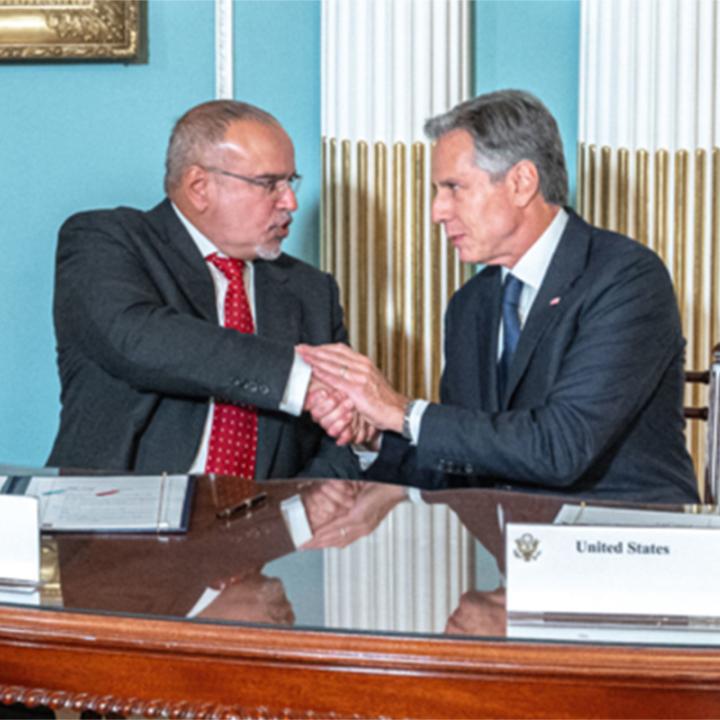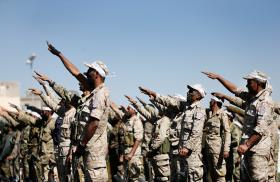
- Policy Analysis
- PolicyWatch 3919
One Year of the U.S.-Bahrain C-SIPA: Signs of Progress, Regional Potential

The progress the two partners have made through C-SIPA offers a fresh model for future U.S. cooperation with other Middle East countries in the security, economic, and technology sectors.
September 13 will mark one year since Secretary of State Antony Blinken and Bahraini crown prince and prime minister Salman bin Hamad al-Khalifa signed the Comprehensive Security Integration and Prosperity Agreement (C-SIPA). In an era when Middle East partners have sought additional U.S. reassurances over fears that Washington might abandon the region, the signing of C-SIPA offers a new roadmap for multinational cooperation. Most notably, it redefines security by expanding beyond military, defense, and intelligence matters into key sectors such as economic and technological cooperation.
C-SIPA’s Strategic Value
The 2023 agreement rests on three core pillars of increased bilateral cooperation: (1) defense and security (including a section on enhanced intelligence sharing), (2) economic, commercial, and trade, and (3) science, technology, and network security. As the United States confronts the region’s most salient challenges—from escalating Iranian aggression to competition with China and questions about the durability of American commitment to the Middle East—designing a structure that offers policy continuity across administrations can help alleviate partner concerns. C-SIPA was designed to provide an innovative model for continuous security and economic integration rather than case-by-case initiatives.
In addition, the security and defense pillar contains an element that many have dubbed “Article 4.5”—a callback to the collective defense clause in Article 5 of NATO’s founding treaty. Specifically, C-SIPA commits Washington and Manama to do the following: “In the event of external aggression or the threat of external aggression against one Party, the Parties shall...immediately meet at the most senior levels to determine additional defense needs and to develop and implement appropriate defense and deterrent responses...in the economic, military, and/or political realms. The Parties stand ready to immediately share available and appropriate information and intelligence in response to such an event.” As Bahraini national security advisor Nasser bin Hamad al-Khalifa put it during remarks at last month’s Aspen Security Forum, the commitment falls “just short of Article 5, but with all the guarantees.”
When C-SIPA was first announced, Iran and its partners appeared to respond immediately: just days after the agreement was signed, a Houthi drone attack along the Saudi-Yemeni border killed four personnel from the Bahrain Defense Force. Because the attack occurred on Saudi soil, it was not viewed as a test case for C-SIPA, but Manama was likely pleased with the strong U.S. statements condemning the attack.
Why Bahrain?
It should come as no surprise that Bahrain was Washington’s first choice when selecting an Arab country for increased cooperation. The small Shia-majority island ruled by a Sunni royal family has long been a key economic, security, and diplomatic partner in the region. Since the two nations formally established relations in 1971, Bahrain has notched the following achievements:
- Hosted the headquarters of U.S. Naval Forces Central Command and the Fifth Fleet, including around 9,000 American military personnel
- Attained formal U.S. recognition as a “major non-NATO ally” in 2002
- Signed a free trade agreement with the United States in 2004 (entered into force in 2006)
- Became the first Arab state to lead a Combined Maritime Forces Coalition Task Force to patrol regional waters
- Participated in the coalition to defeat the Islamic State
- Provided personnel for the International Security Assistance Force in Afghanistan
- Became a founding signatory to the Abraham Accords with Israel
Indeed, Manama has repeatedly demonstrated both its commitment to the strategic partnership with the United States and its political willingness to support American initiatives in the region.
Bahrain also stood to gain a great deal from a security pact with Washington. Sitting just one hundred nautical miles from Iran, the island has foiled multiple attempted attacks by Tehran-backed groups and broke off diplomatic relations with the regime in 2016. Although Manama is working to restore those relations, its general alignment with the United States in the security and policy spheres makes it a good candidate for testing a new kind of agreement with Middle East partners.
What Has C-SIPA Accomplished?
Bahrain and the United States were already jointly pursuing many of the initiatives put forward in C-SIPA, but the agreement helped breathe new life into their planning and accelerate implementation. Over the past year, progress has been made on all three of the agreement’s core pillars:
Defense and security. After the Houthis stepped up their attacks on vessels in local waters last November, the United States rolled out several multilateral initiatives to protect international shipping. Bahrain was the only Arab country to join every initiative. On December 19, it attended the Red Sea ministerial meeting at which Defense Secretary Lloyd Austin announced Operation Prosperity Guardian, a defensive coalition meant to reassure the shipping sector about safe passage. Weeks later, Bahrain joined a smaller coalition supporting U.S.- and British-led strikes against Houthi targets in Yemen. It also played a role in the integrated air defense that helped intercept hundreds of Iranian ballistic missiles and drones launched at Israel on April 13.
Additionally, C-SIPA has helped reinvigorate bilateral defense consultation groups and security cooperation. Last month, U.S. officials hosted the U.S.-Bahrain Military Consultative Committee and held discussions with Sheikh Nasser during his aforementioned visit. On both occasions, the two governments reaffirmed their support for C-SIPA and discussed further ways to deepen the partnership. The United States has also delivered on several initiatives that were already in the pipeline. In March, for example, three F-16 Block 70 jets were delivered with an additional thirteen to follow; Bahrain will soon be the first Persian Gulf country to integrate the variant into its fleet. All of these moves demonstrate each partner’s clear commitment to meet C-SIPA’s security and defense objectives.
Economic, commercial, and trade. C-SIPA formally made Bahrain a strategic commercial and trade partner, signaling to U.S. companies that it was a trusted destination for investment. While not much public progress has been made on this pillar, both countries are working to identify key areas for expanded economic cooperation.
One example is the push for direct flights from the United States to Manama via Bahrain’s flag carrier Gulf Air—an initiative accelerated by the signing of C-SIPA. Although U.S. officials have no control over the commercial aspect of restoring direct flights (which were halted in 1997 for technical and financial reasons), they have expedited critical steps in the process (e.g., the Federal Aviation Administration conducted a mandatory oversight visit with Bahrain’s Civil Aviation Affairs this June).
Science, technology, and network security. The low-hanging fruit of cooperation on this pillar is cybersecurity. Bahrain’s private and public networks have been repeatedly targeted by cyberattacks, lending further urgency to discussions of in-depth cooperation on this front. The United States has also been promoting research and development in this field, including matchmaking between American universities and Bahraini institutions.
In November, the Los Angeles-based cybersecurity and intelligence company Resecurity announced the opening of a Manama office that will serve the wider Gulf region, supported by the Bahrain Economic Development Board. The firm has also committed to setting up a technology hub that will include training programs in cybersecurity, boosting Bahraini government initiatives to diversify the country’s highly skilled workforce. These announcements—the first of their kind for Bahrain—have helped solidify the island’s status as an attractive investment opportunity for global technology companies.
What’s Next?
Although most of the results that C-SIPA has yielded so far stem from reinvigorating existing initiatives, the agreement’s potential for wider collaboration is exponential—though perhaps on some pillars more than others. The defense and security pillar has not yet been fully tested, since only an attack on Bahraini soil would likely trigger the threat-response clause. As such, it is difficult to assess whether Manama would be satisfied with the U.S. response to this scenario. Moreover, a prospective U.S. defense treaty with Saudi Arabia might overshadow C-SIPA, potentially making the latter format less attractive if regional partners believe binding defense treaties are on the table.
On the economic pillar, Bahrain is a prime candidate to leverage what Treasury Secretary Janet Yellen termed “friendshoring”—that is, strengthening America’s economic resilience by “diversifying supply chains across a wide range of trusted allies and partners.” The twentieth anniversary of the U.S.-Bahrain free trade agreement falls on the same week as the anniversary of C-SIPA—the United States should use these dual anniversaries to market the island as a trusted partner for the private sector. It should also consider granting Manama’s request to repeal U.S. tariffs that were originally put in place to protect the American aluminum industry. In addition to acknowledging the upgraded relationship, this step could help Bahrain become a trusted aluminum supplier at a time when high energy costs and Chinese competition have reduced U.S. domestic production.
In the technology sector, future growth depends in part on Washington’s ability to convince more investors that Bahrain is a reliable partner with a suitably specialized workforce. The island’s 2018 Personal Data Protection Law, the first of its kind in the world, enhances legal protections for individuals, companies, and their data—a big draw for the private sector. Manama also maintains a “cloud-first policy,” requiring government agencies to prioritize the implementation of secure cloud computing technologies. In 2019, Amazon Web Services (AWS) chose Bahrain as the site of its first cloud infrastructure in the Middle East. By demonstrating U.S. commitment to future technological integration and meshing with Bahrain’s unique laws and policies, C-SIPA can help attract more technology companies.
More broadly, Washington and Manama have publicly stated their intent to expand C-SIPA beyond a bilateral agreement, pulling in like-minded countries in the Middle East and beyond. Despite the formidable regional obstacles to this goal, C-SIPA offers an unparalleled opportunity to build out an integrated security and defense structure while simultaneously forming a network of trusted partners for economic development and technological integration.
Elizabeth Dent recently joined The Washington Institute as a senior fellow after serving as director for the Gulf and Arabian Peninsula at the Pentagon.



